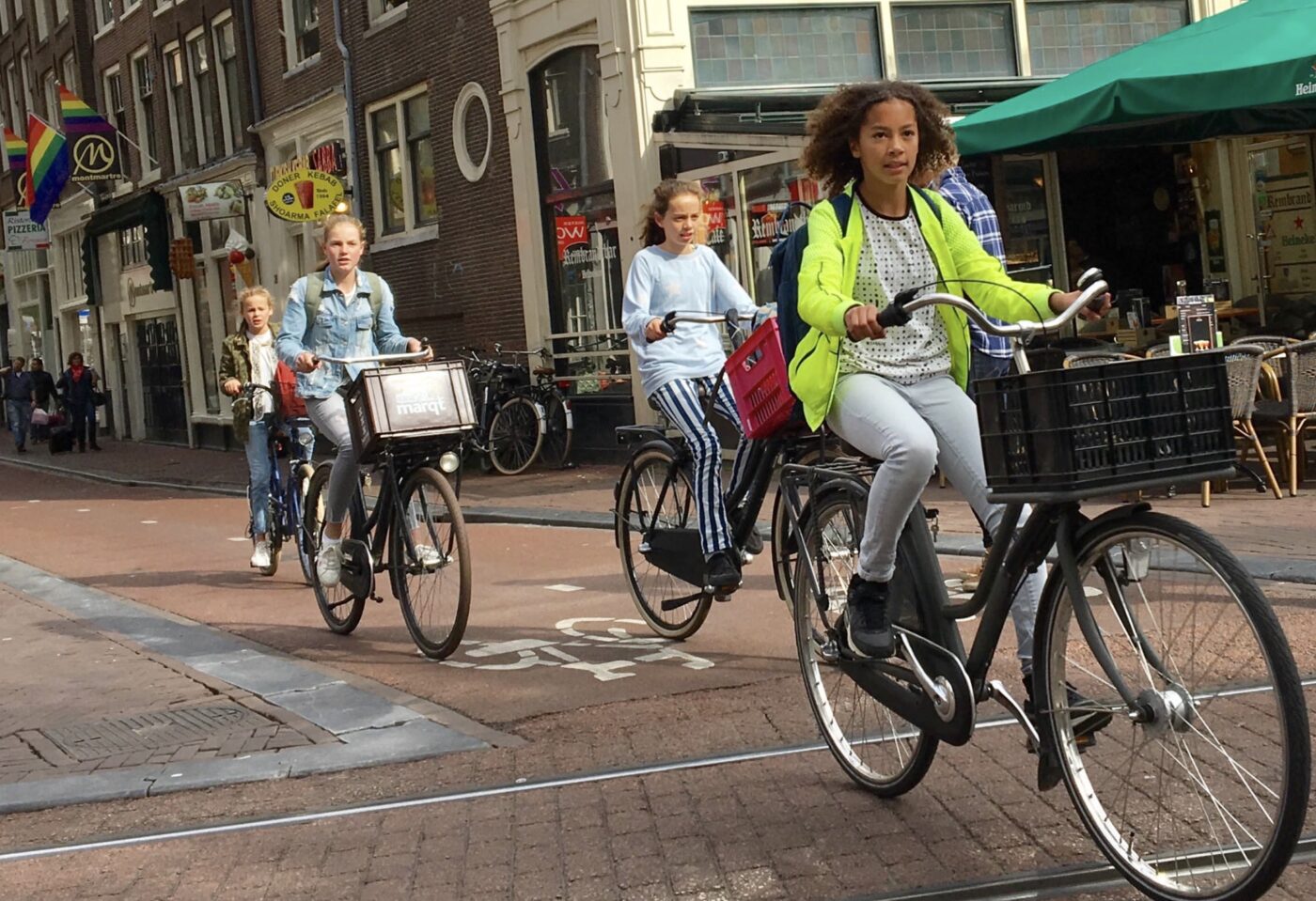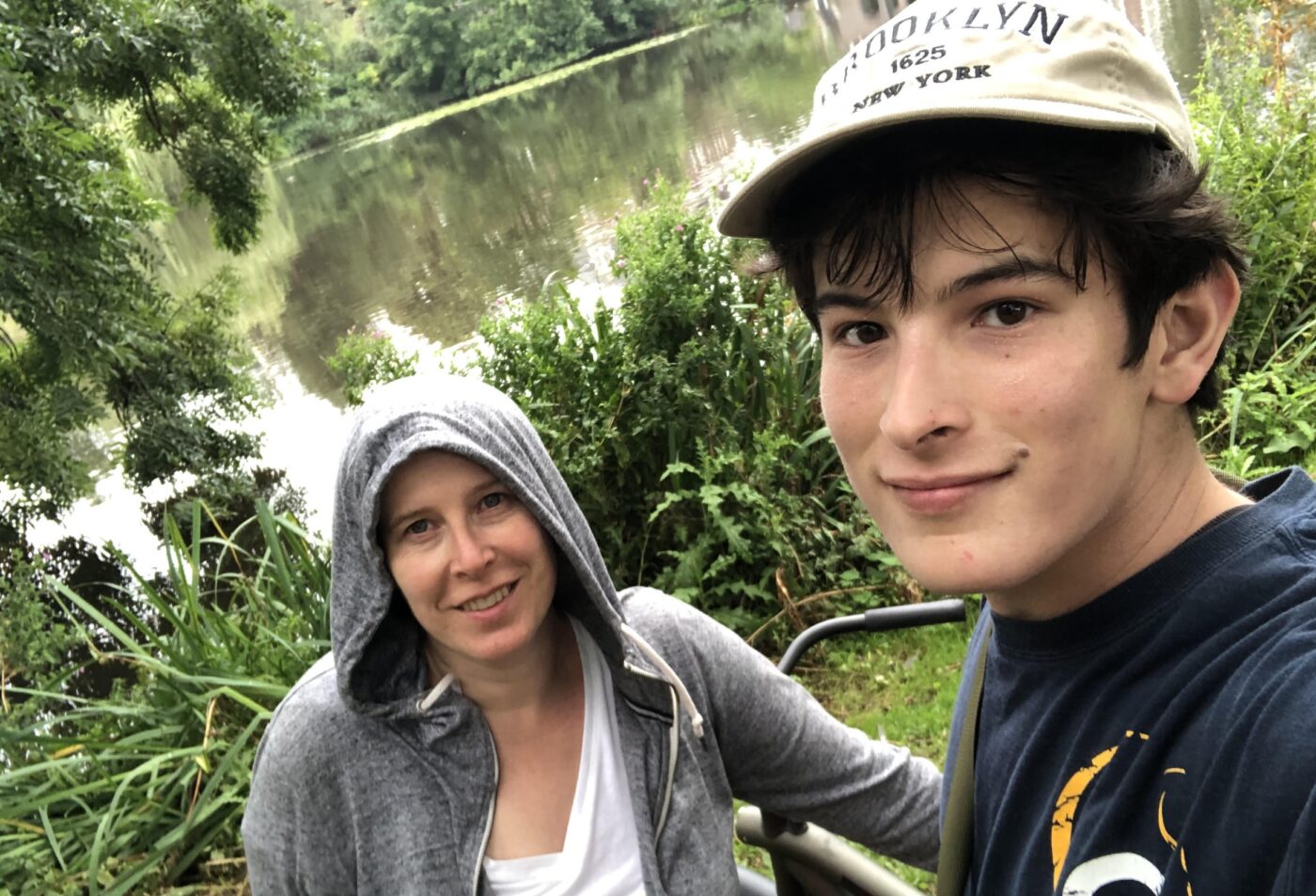— By Jen Guzman, Portland resident
“When I ride in Portland, I feel like there’s a target on my back… Here, it’s just fun and easy.”
– My 17-year-old son
This summer I spent nine days in Amsterdam with my 18-year-old son, eager to explore the city on two wheels. So much is written on the city’s transformation into a biking mecca that it almost feels cliche to visit and write about Amsterdam. I wondered if there was anything new I could learn and share.
Despite years of biking in Portland, it took me a minute to adjust to Amsterdam’s critical mass of bikes. I wasn’t used to navigating in such tight packs of bikes and the rules of the road weren’t always obvious. I learned quickly that a bike-centric city, while a huge improvement over a car-centric city, is not a utopia. Jerks on bikes will cut you off and curse you, much like some drivers on I-84. And also like many cars, very few bikes stop at crosswalks for pedestrians. In Amsterdam, cars tended to drive passively and slowly, yielding to bicycle and pedestrian traffic. I was in The Upside-Down World.
But by my second day, biking in Amsterdam felt easy and often joyful. The city is a giant maze of well-maintained bike paths with excellent signage. It felt like riding on a race track. No need for hunting down a bike lock and helmet because Amsterdam bikes have built-in wheel locks and no one wears helmets. I just hopped on my rental bike and rode away for the day. Bike parking was plentiful. The bike fashion scene was on point.
My 18-year-old son, who will typically choose TriMet to get around Portland, biked in Amsterdam. Even after experiencing the efficiency of Amsterdam’s public transportation system, he loved the thrill and adventure of biking the city. But he said something that struck me while we were biking through Vondelpark one day.
“Mom, when I ride my bike in Portland, I feel like there is a target on my back. As if it’s only a matter of time before I get hit by a car. Here, it’s just fun and easy.”
I understood exactly how he felt. While a small element of danger existed due to the sheer number of bikes in Amsterdam, getting clipped by another bike had far less consequences than anything a car would do to us.
Coming back to the U.S. and saddling back on my bike, I felt a visceral loss of freedom and safety. And I think I finally accepted traffic violence as a true epidemic facing our city and country.
The risk of death for people on foot or bike was 23 per million in the Netherlands in 2019. In the US, that same risk in the same year was 686 per million. Pedestrian and biking deaths in the U.S. have increased 77% since 2010 and last year 7,508 people were struck and killed by vehicles, the highest number in 41 years. In Portland, 63 people have died this year by traffic violence, continuing the upward march of fatalities in our city that reflects national trends.
It is important to understand that Amsterdam wasn’t always bike nirvana. In the 1960s, cars began to clog the streets. The city faced a crossroads. Would it become car-centric like other international cities? Some city planners proposed dismantling historic neighborhoods and paving over the city’s beautiful canals to accommodate more cars. After walking and riding through those beautiful neighborhoods, that feels nothing short of tragic.
As cars filled the roads and deaths linked to cars increased, people throughout the Netherlands organized and protested. The STOP de Kindermoord, or “Stop The Murder of Children” movement pressured the government to do more to curb traffic violence. The Dutch are nothing if not direct.
This strong advocacy forced change. The government lowered car speed limits and added bike routes, and as a result, more and more people chose to bike. Today, more than half of all trips in the central area of Amsterdam are done by bicycle.
Amsterdam city leaders continue to aggressively incentivize bike use by closing streets to cars, reducing parking (there is currently a plan to remove car parking along the city’s canals), and continuing to invest in bike infrastructure. To reach their vision of a safer, more livable city with a smaller carbon footprint, Amsterdam made biking the easiest way to get around town.
After spotting a good number of riders smoking and vaping on their bikes, I am convinced the Dutch ride less for their health, and maybe even less out of concern for the environment, and more for pure convenience. We, as humans, tend to do what is easiest.
Maybe that is part of the power of travel: Experiencing a better way to live and realizing the status-quo back home, in this case, rising traffic violence, is not acceptable. I have great appreciation for the work of groups such as Families for Safe Streets Oregon/Washington, and The Street Trust, who advocate for safer streets — and I have newfound energy to immerse myself in the work of making our streets safer.
Despite the differences between our cities and the political opposition we often face here in the United States, we can get closer to our goals of safer streets by continuing to do the hard work of education and advocacy.
Once you’ve biked the streets of Amsterdam, it’s hard to sit back and do nothing.
— By Jen Guzman, Portland resident





